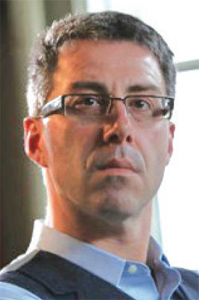|
August 2015

Issue Home >>
|
 
In his keynote presentation on the second day of the Institutionalisng Best Practice in Higher Education conference, Dr Dan Butin, Professor and founding Dean, School of Education and Social Policy at Merrimack College, discussed the key challenges and insights gained in the last two decades for teaching and learning in higher education. His presentation focused on best practices for student engagement and high-impact practices and offered a vision of fostering transformation from shallow to deep learning. Professor Butin also made the claim that such a scholarship of teaching and learning must take into account the rise of digital learning technologies, student backgrounds and aspirations, and the civic role of higher education in our society.
Professor Butin grounded his presentation in the seminal works of John Dewey and supported his premise that “one can’t talk about teaching unless someone is learning,” as well as on his observation that that there are numerous best practices around teaching but few best practices around learning, although our research shows that we are cognisant of how learning works. He illustrated our knowledge of how learning works by reviewing research over the last 100 years, from a philosophy of teaching to a science of learning. He identified cognitive psychology, cognitive science, learning sciences, discipline-based educational research, and scholarship of teaching and learning as respectively exploring the essence of how learning works. The outcome of research in these areas was a move towards student engagement. Professor Butin illustrated Dewey’s (1938) suggestion in his book Experience and Education that the role of the teacher shifted from the sage on the stage to the guide on the side. This concept evolved further with Merrienboer’s (2012) four-component instructional design for complex learning which illustrates the progression from teaching to learning back to teaching.
Critical to Professor Butin’s presentation, though, was his elucidation of high-impact practices in education based on the work of Kuh (2008). Butin identified high-impact practices as falling under three headings: common intellectual experiences, experiential education, and education that matters. He cited common intellectual experiences as events such as learning communities, first-year seminars and experiences, and collaborative assignments and projects. Under experiential education, he highlighted undergraduate research, diversity/global learning, and service learning or community-based learning. For education that matters, he cited internships, writing-intensive courses, and capstone courses and projects. He suggested that high-impact practices encourage and facilitate self-authorship, project-based learning, inquiry learning, and backwards design curricula, usually in iterative processes. The culmination of these high-impact practices is that students engage academic content, their peers, mentors, and community towards an improved future.
Nevertheless, Professor Butin questioned: While all of the foregoing can and do work, why are there still so many challenges to effective teaching and learning? For one thing, he highlighted the fact that teaching is easy but learning is hard; and that as learning is a process and not merely a product, we need to help students learn how to learn, and turn them from passive learners to become critically reflective individuals with qualities of good contributing citizens. Professor Butin was highly critical of what he described as the Egg Crate or Factory Model of education. He indicated that in this model we continue to isolate students in the classroom, and focus on where we can control our students even as we engage in conversations about access and quality. The obvious challenges are further complicated by the ‘massification’ of education, the implosion of the academy, and unacceptable or questionable outcomes for student learning, retention, and graduation rates.
Professor Butin suggested that The UWI is at a pivotal point in its system of education. Therefore, it is now imperative that we reflect on our system and decide on whether teaching and learning is simply transfer of information or transformation of knowledge. He also suggested that it might be time for the institution to move from the idea of the flipped classroom to the flipped university. He drew on the impact practices to outline the features of the flipped university. Professor Butin’s vision of the flipped university encapsulates three core components: it is student-centred, project-centred, and impact-centred. In a student-centred institution, the lecture is outsourced, discussion is central to learning, deep learning occurs, and the instructor is a curator of knowledge. In a project-centred institution, the class is outsourced, learning is authentic, the instructor is researcher, and outcomes are central. In an impact–centred institution, the “checklist” mentality is outsourced, deep and authentic learning evolves through scaffolding, a distinctive university experience is established, and transformation is central. This leads to the “engaged university.” The flipped university is an embedded outline guided by political will, where boundaries of the university are boundaries of the state or nation.
In this context, knowledge is transformed for the betterment of society. Without this transformation of thought and practice we can become obsolete in a changing education, globalised context. The discussion must continue if the university is to remain relevant. |





